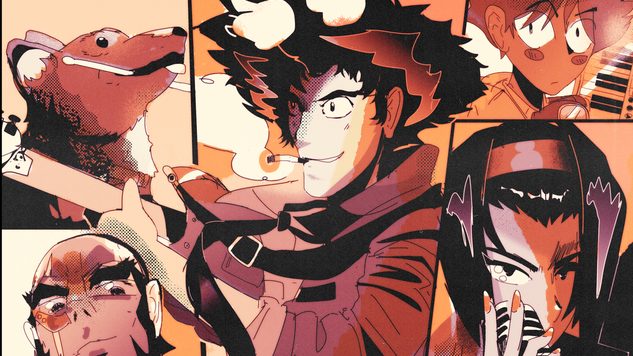The Real Folks Blues Kickstarter Zine Celebrates Cowboy Bebop’s Enduring Legacy
Main Art by Patrick Crotty
There are few anime whose popularity and impact in the West is matched by that of Cowboy Bebop. Produced by Sunrise Inc. and directed by the now-legendary Shinichiro Watanabe, the series is credited not only as a highwater mark for anime of its period, but also for introducing a generation of western audiences to the medium in the early 2000s. Following a misfit crew of bounty hunters searching for their next big score while reconciling with the ghosts of their past, the series set itself apart from its ilk with its mature themes, dazzling animation, anachronistic mashup of sci-fi noir and western action-drama and its unimpeachably iconic score composed by Yoko Kanno and The Seatbelts.
This year marks the 20th anniversary of Cowboy Bebop. The original 26-episode series and accompanying film Knockin’ on Heaven’s Door consistently rank among the greatest anime series and movies ever produced, and with rumblings of a possible live-action adaptation brewing as recently as last year, it’s safe to say that the stories of the Bebop crew are more than capable of standing the test of time.
All the more reason why publisher and critic Zainab Akhtar and her publishing press ShortBox have put together The Real Folk Blues, a fan anthology of comics, illustrations and essays celebrating the legacy of Watanabe and co.’s magnum opus by a host of artists and writers who know and love the series best. Paste reached out to Akhtar over email to talk about the origins behind the book, why Cowboy Bebop endures in the year 2018 and what might lie ahead after this Kickstarter campaign reaches its goal.
![]()

The Real Folk Blues Cover Art by Patrick Crotty
Paste: A 130-plus page fan anthology is no simple task, let alone one devoted to arguably the most iconic anime series of the late ‘90s. Where did the idea for this book first come from, and how are you putting it together? (Besides Kickstarter, that is.)
Zainab Akhtar: Earlier this year, I edited and produced my first fan-zine, a 30-odd page book of comics and illustrations dedicated to Pingu, a (ostensibly) children’s claymation series that ran in the ‘90s. I was lucky enough to have some flat-out superb artists come on board: Nico Delort, Luke Pearson, Jessi Zabarsky, Lottie Pencheon, Rosie Brand, Joe Decie and many more. Putting together a fan-zine felt really different to working on something completely “new.” There’s a shared pool of passion everyone’s drawing from: we’re all familiar with the source material, and most often, we’re all participating simply because we love the material to the degree that we want to pay homage to it, and create new art and stories that convey that passion. Once the Pingu zine was wrapped, I was both inordinately proud of it and immediately wanted to work on another fan-zine. I floated the idea of a Cowboy Bebop one on my Twitter, and the response was overwhelming. Bebop is so loved and highly regarded but there’s not a ton of fan-material (or even many affiliated products) out there, so that helped the decision in terms of which property to take on, rather than doing something on The X-Files, for example.
Paste: The list of contributors for the book is absolutely stacked with heavy-hitting comic artists, from Nick Dragotta (East of West) and Ron Wimberly (Prince of Cats) to Jane Mai (Sunday in the Park with Boys) and Vivian Ng (Legend of Korra). How long has the book been in production? How did you manage to pull this many names together?
Akhtar: The book has been in production since May and that initial tweet. In terms of pulling together artists, I think I had around 500 responses via Twitter and email from interested artists and writers. Quite a few were names I knew, whose work I appreciated so that side of things was easy to select. The rest: I went through every single person who responded individually, checking out their portfolios/sites/blogs/etc., and selected accordingly. I trust my eye…as strange as that may sound! I’m very lucky in that I’ve worked with a lot of amazing cartoonists, artists and writers—and those people where I hope the experience has been mutually decent, I’m always happy to work with again. I enjoy building working relationships with cartoonists where possible. I think seven of the people involved are people I’ve worked with previously, and lots of others are people I know either from when I was writing about comics or as a publisher. A few I reached out to at a later date, after having some people drop out. I’m very grateful to have people place their trust me.

